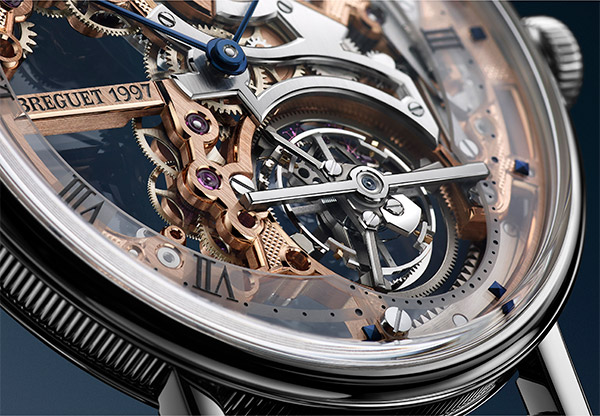It was first launched in 2017 with a silver guilloché dial, Breguet’s aesthetic signature. In 2018, a version with a white grand feu enamel dial provided a different kind of showcase for one of Breguet’s most exceptional movements – exceptional because of its sophistication, rather than the number of complications. At the time, the self-winding tourbillon calibre 581 with peripheral rotor advertised a very creditable thickness of just 3 mm, which meant the cases of these first two versions required a depth of just 7.70 mm. This is approaching record-breaking territory, but that’s not their most notable feature. The fact is, they are exceptionally comfortable to wear.

Breguet unveiled the third version based on this calibre at its manufacture in the Joux Valley during the 2019 Time 2 Move event. This latest version, the Classique Tourbillon SQ 5395, sports the same 41 mm diameter and 7.7 mm thickness, but it is skeletonised. But skeletonisation is only the start of what this model is about. Skeletonisation is a protean exercise, after all. It can produce results as varied as horological creativity allows. And on this model in particular, Breguet showcases more than one of its talents.

The first is obviously... skeletonisation. This exercise has led to the removal of 50% of the movement’s mass, mainly from the most solid part of the movement, the baseplate, which has vanished almost entirely, leaving only the edges. They are essential because they are where the self-winding system is anchored. The movement is wound by the rotor, which has one thicker half made of platinum. This unbalance sets the weight in motion and, by means of internal teeth, drives the winding gears that connect to the barrel. The barrel is also skeletonised on both sides. The bottom features a constellation of small circles, reflecting the appearance of the movement itself, which is characterised by extreme openworking that emphasises the functional rubies. And, by the way, the barrel is very powerful, providing a power reserve of 90 hours. Because of that, some material has to be left in, to avoid twisting the movement.

What is left of the baseplate provides a canvas for one of Breguet’s other specialties, guillochage. The few solid areas of the movement pass through the manufacture’s rose engine lathes. And, because Breguet reserves the guillochage treatment for precious metals exclusively, the calibre is made of solid gold. The watch comes in two versions: the first has a case made of 9590 platinum with a rose gold calibre, and the second comes in a rose gold case, with a rhodium-plated calibre.

And, of course, where there is skeletonisation, there is plenty of chamfering. The lengthy edges of the residual components are all slowly, painstakingly bevelled. These bevels are then smoothed and, finally, polished. All this is done entirely by hand, with traditional tools. Given the thinness of the components, it’s almost impossible to imagine the patience required to carry out this operation on the entire movement. The tourbillon, however, has not been touched. It still has the distinctive bar bridge. It beats at 4 Hz and has a silicon pallet, pallet wheel and balance spring. This component doesn’t lend itself to skeletonisation, which is why it’s the only part of the Classique Tourbillon SQ 5395 that has been left intact.




